|
Egypt |
|
Treasures and Mysteries of Ancient Heracleion
Photos by Franck Goddio
Colossus of a Ptolemaic queen made out of red granite. The
whole statue measures 490 cm in height and weighs 4 tons. It was found
close to the big temple of sunken Heracleion. ©Franck Goddio/Hilti Foundation, photo: Christoph GerigkHeracleion (Greek: Ἡράκλειον), also known as Thonis (Θῶνις), was
an ancient Egyptian city near Alexandria whose ruins are located in Abu
Qir Bay, currently 2.5 km off the coast, under 10 m (30 ft) of
water. Its legendary beginnings go back to as early as the 12th
century BC, and it is mentioned by ancient Greek historians. Its
importance grew particularly during the waning days of the Pharaohs—the
late period, when it was Egypt's main port for international trade and
collection of taxes.
Heracleion was originally built on some adjoining islands in the Nile Delta, and was intersected by canals. It possessed a number of harbors and anchorages, was the sister city of Naucratis, and was superseded by Alexandria. 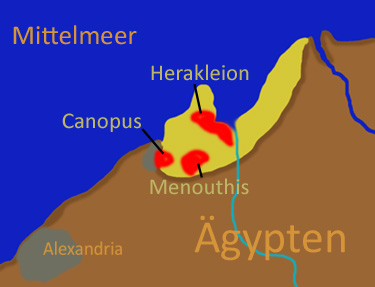
Map of Nile Delta showing ancient Canopus, Heracleion, and Menouthis
Legendary beginnings
 The stelae of Ptolemy VIII from the temple of Heracleion It was believed that Paris and Helen of Troy were stranded here on their flight from the jealous Menelaus, before the Trojan war began[citation needed] or that Menelaus and Helen had stayed there, accommodated by the noble Egyptian Thon and Polydamna. Also, it was believed that Heracles himself had visited the city, and that the city had gained its name from him. Ancient references Until very recently the site had been known only from a few literary and epigraphic sources, one of which interestingly mentions the site as an emporion, just like Naukratis. — British Museum, 2013 The city was mentioned by the ancient historians Diodorus (1.19.4) and Strabo (17. 1.16). Herodotus was told that Thonis was the warden of the Canopic mouth of the Nile: Thonis arrested Alexander (Paris), the son of Priam, because Alexander had abducted Helen of Troy and taken much wealth. Heracleion is also mentioned in the twin steles of the Decree of Nectanebo I (the first of which is known as the 'Stele of Naukratis'), which specify that one tenth of the taxes on imports passing through the town of Thonis/Herakleion were to be given to the sanctuary of Neith of Sais. The city is also mentioned in the Decree of Canopus honoring Pharaoh Ptolemy III. The city of Heracleion was also the site of the celebration of the ‘mysteries of Osiris' each year during the month of Khoiak. The god in his ceremonial boat was brought in procession from the temple of Amun in that city to his shrine in Canopus. Archaeology 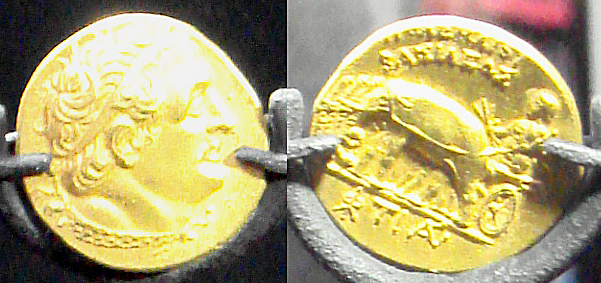 Ptolemaic coins from the submerged Heracleion
The city had a large temple of Khonsou, son of Amun, who
was known to the Greeks as Herakles. Later, the worship of Amun became
more prominent.Heracleion flourished especially from the 6th to the 4th century BC, as revealed by numerous archaeological finds. Pharaoh Nectanebo I made many additions to the temple in the 4th century B.C. The city sank in the 3rd or 2nd century AD, probably due to liquefaction of the silts on which it was built following earth tremors. The ruins submerged in the sea were located by the French underwater archaeologist Franck Goddio in 2000. Until then, the scholars were not sure if Heracleion and Thonis were in fact one and the same city.  Recreation of The Lost City of Heracleion in Al Maadeyah, Egypt: An ancient city exhumed from the depths of the ocean. SOURCE: Heracleion Thonis-Heracleion: From Legend to Reality - Franck Goddio Official Site |
|
|
Ancient City Discovered Underwater Solves Enigma that
Puzzled Egyptologists for Years 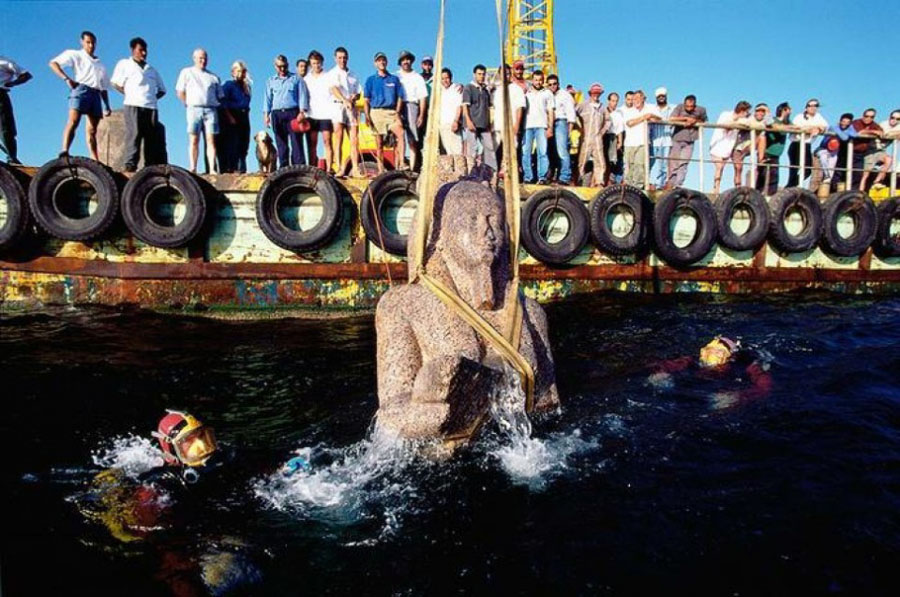 Photos by Franck Goddio
Franck Goddio and his team with
a colossal statue of red granite (5.4 m) representing the god Hapi,
which decorated the temple of Heracleion. The god of the flooding of the
Nile, symbol of abundance and fertility, has never before been
discovered at such a large scale, which points to his importance for the
Canopic region. ©Franck Goddio/Hilti Foundation, photo: Christoph GerigkFranck’s discovery accomplished many things including uncovering important information about the ancient landmarks of Thonis-Heracleion, such as the grand temple of Amun and his son Khonsou (Herakles for the Greeks), the harbours that once controlled all trade into Egypt, and the daily life of its inhabitants. Through his discovery he was able to solve a historic enigma that has baffled Egyptologists for years, that Heracleion and Thonis were actually the same city with two different names.  Photos by Franck Goddio Head of a pharaoh
statue is raised to the surface. The colossal statue is of red granite
and measures over 5 metres. It was found close to the big temple of
sunken Heracleion. ©Franck Goddio/Hilti Foundation, photo: Christoph Gerigk
As you will see in the pictures, the relics recovered from the excavations boldly reveal the cities’ beauty and glory before it was buried by water. Anything from colossal statues, inscriptions and architectural elements, jewellery and coins, ritual objects and ceramics, were found and each reveals the opulence Heracleion experienced during its time. Many of the finds illustrate how crucial this city was to the ancient world economy. This is also seen by the huge amount of gold coins and bronze, lead and stone weights used to measure value of goods in ancient times. The importance of Heracleion has also been proved by the discovery of 64 ships, which is the largest number of ancient vessels ever found in one place. Along with these ships, a mind-boggling 700 anchors were found on the ocean floor. The discoveries include a huge statue of the god Hapi, a statue of the classic Egyptian goddess Isis, a head of an unidentified Pharaoh and a number of smaller statues of Egyptian gods, figures and queens. Interestingly, dozens of sarcophagi containing the bodies of mummified animals sacrificed to Amun-Gereb were found. According to Egyptian history, Amun-Gereb is the supreme god of the Egyptians. While it may not be the discovery of the coveted Atlantis, this discovery certainly has its own profoundness and beauty. SOURCE: Ancient City Discovered Underwater Solves Enigma that Puzzled Egyptologists for Years Thonis-Heracleion: From Legend to Reality - Franck Goddio Official Site |
|
|
Treasures and Secrets of Ancient Heraklion
Translated from Russian
The Statues of Heracleion and Canopus, Abu Qir Bay, Egyp More
than 1,200 years ago on the Mediterranean coast of Egypt was one of the
most important cities of ancient times - Heraklion. Its strategic
location has made it the main center of maritime traffic in the region
and the engine of economic development of its era. What little is known
about its history, reflected in the writings of Homer, who told of
visiting Heraklion Helen of Troy and Paris - two of the most famous
characters in Greek mythology.
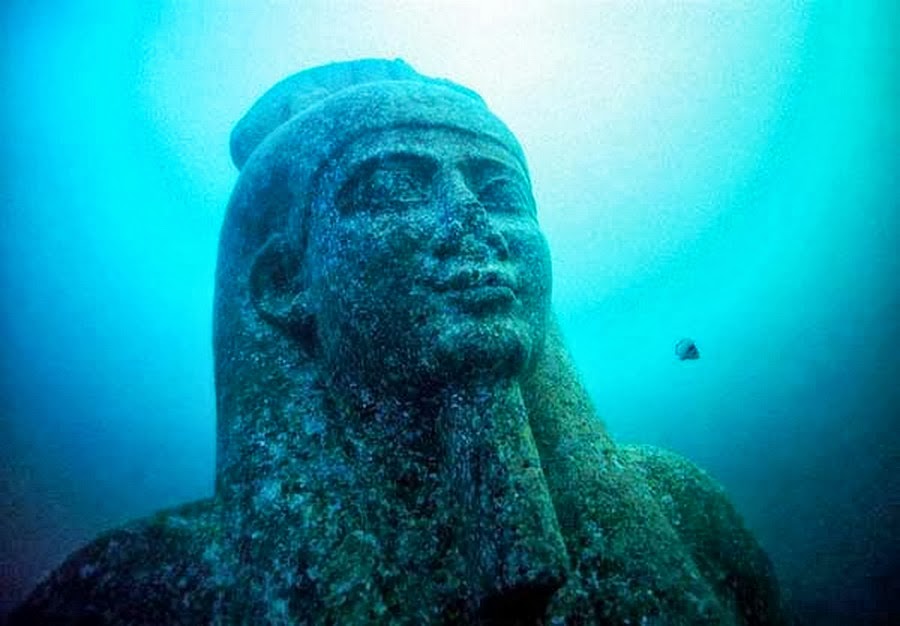 Photos by Franck Goddio Head of a colossal
statue of red granite (5.4 m) representing the god Hapi, which
decorated the temple of Heracleion. The god of the flooding of the Nile,
symbol of abundance and fertility, has never before been discovered at
such a large scale, which points to his importance for the Canopic
region. ©Franck Goddio/Hilti Foundation, photo: Christoph Gerigk
According to historical records, Heraklion, located in the delta of the Nile, was established in the 8th century BC and disappeared around the year 700 as a result of a chain of disasters, immerse the bottom of the Mediterranean Sea. The question as to whether there was in fact Heraklion or not, always troubled historians and archaeologists as long as 10 years ago, an underwater archaeologist Franck Goddio Frenchman, has not found his remains at the bottom of the sea. Since then, the scientist did not stop to search and explore what was hidden under the water for 12 centuries. Most recently, he published a series of photographs and videos that show a lot of treasures and secrets that still keeps the ancient city, immersed to a depth of 45 meters. Photos by Franck Goddio
An archaeologist measures the feet of a colossal red granite statue at the site of Heracleion discovered in Aboukir Bay.
©Franck Goddio/Hilti Foundation, photo: Christoph Gerigk
Archaeological finds consisted of 64 Egyptian ships built between the VIII and II centuries BC, imposing statues 5-meter-high, 700 anchors, more than 300 figurines and amulets and countless gold coins. Underwater landscape of the city paints a picture that looked like the era of Heraklion in its highest development, as well as can be seen in the remains of a grand temple dedicated to the supreme god Amon-Herebu. According to the Franck Goddio, in these waters continue to hide an infinite number of artifacts and an important part of the history, the study of which will take at least another 200 years. The most surprising in this finding is that the ideal state in which preserved all found objects, whose age is more than 1200 years. Natural protection in the form of a sea of ??mud and sand allowed the majority of the artifacts come to our days in almost original form. 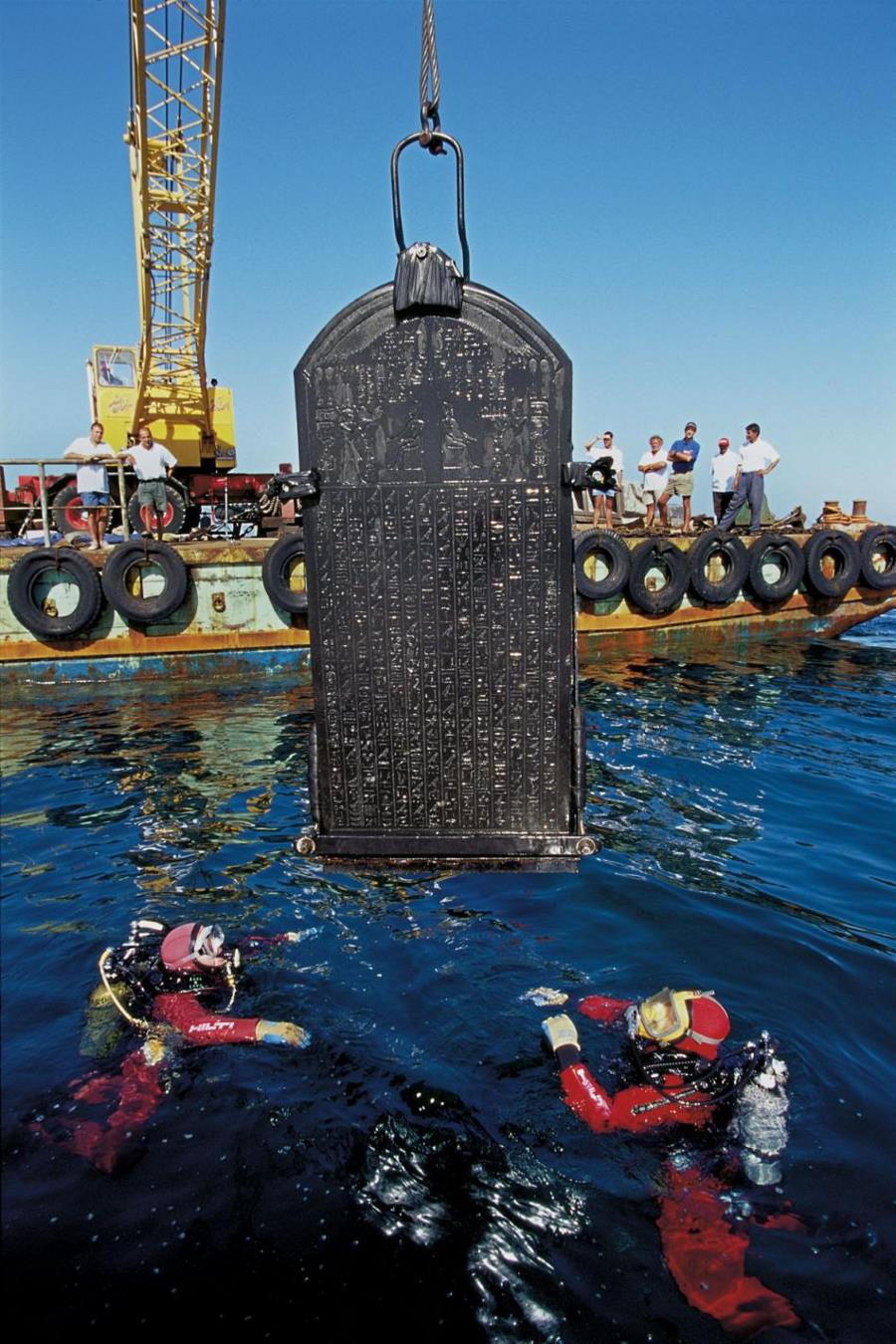 Photos by Franck Goddio Here, the buried art and ruins are being carefully extracted from the water. The
stele of Thonis-Heracleion (1.90 m), ordered by Pharaoh Nectanebo I
(378-362 BC), is almost identical to the stele of Naukratis in the
Egyptian Museum of Cairo. The text of the stele mentions the site where
it was erected: Thonis. ©Franck Goddio/Hilti Foundation, photo: Christoph Gerigk
SOURCE: Russian treasure Huntere "Feetgroup" Thonis-Heracleion: From Legend to Reality - Franck Goddio Official Site |
|
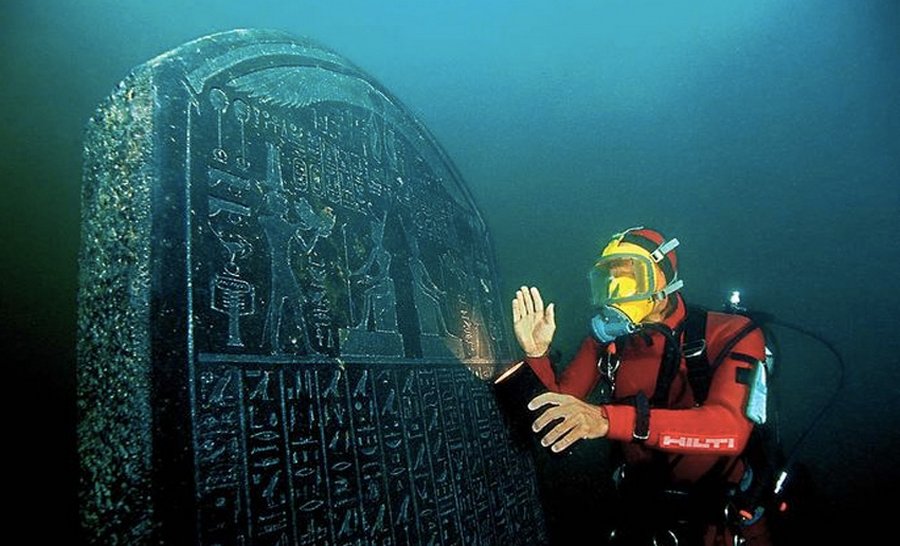 Photos by Franck Goddio Franck Goddio with
the intact and inscribed Heracleion stele (1.90 m). It was commissioned
by Nectanebo I (378-362 BC) and is almost identical to the Naukratis
Stele in the Egyptian Museum in Cairo. The place where it was to be
situated is clearly named: Thonis-Heracleion. ©Franck Goddio/Hilti Foundation, photo: Christoph Gerigk
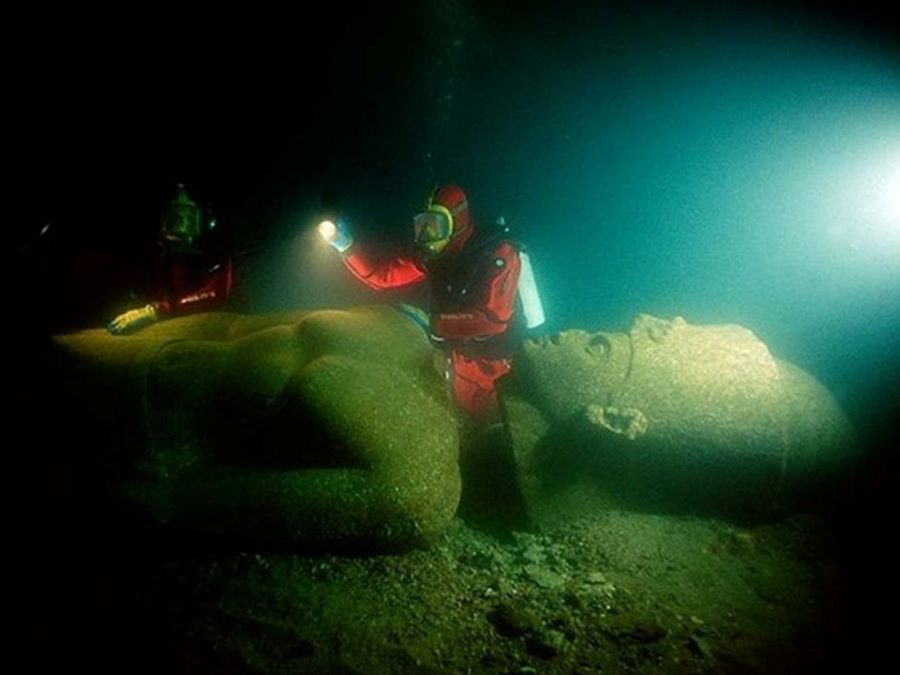 Photos by Franck Goddio Franck Goddio and
divers of his team are inspecting the statue of a pharaoh. The colossal
statue is of red granite and measures over 5 metres. It was found close
to the big temple of sunken Heracleion. ©Franck Goddio/Hilti Foundation, photo: Christoph Gerigk
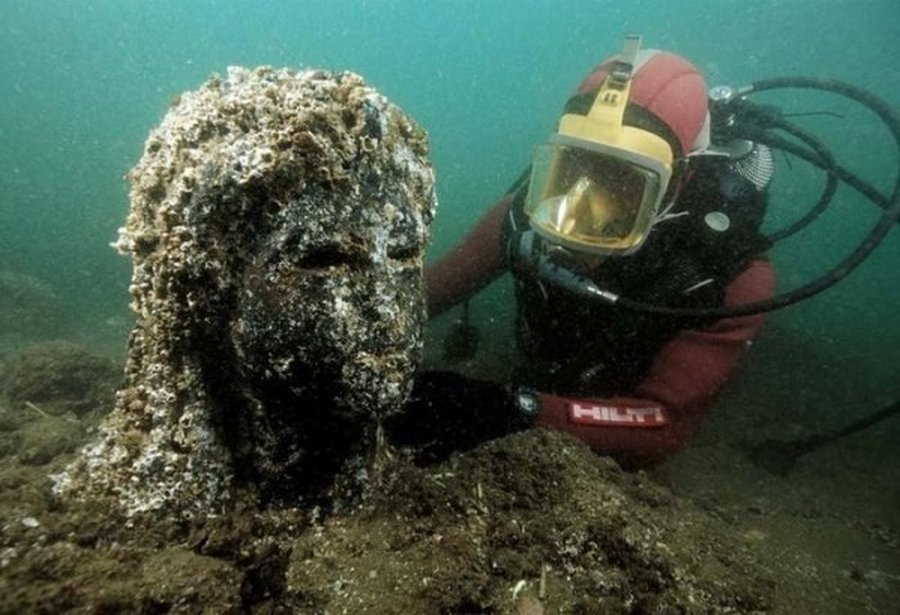 Photos by Franck Goddio 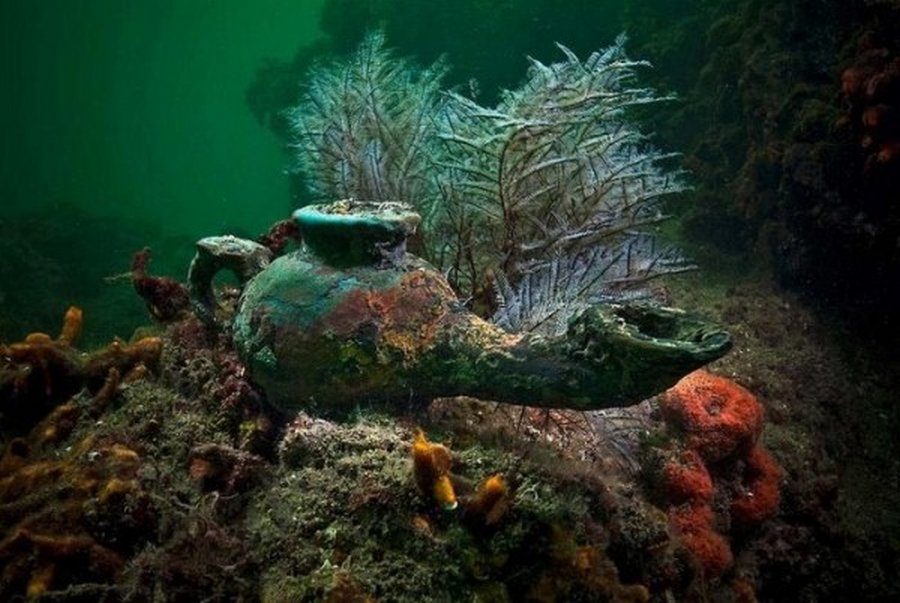 Photos by Franck Goddio Bronze oil lamp (late Hellenistic period, about 2nd century BC) discovered in the temple of Amun. ©Franck Goddio/Hilti Foundation, photo: Christoph Gerigk 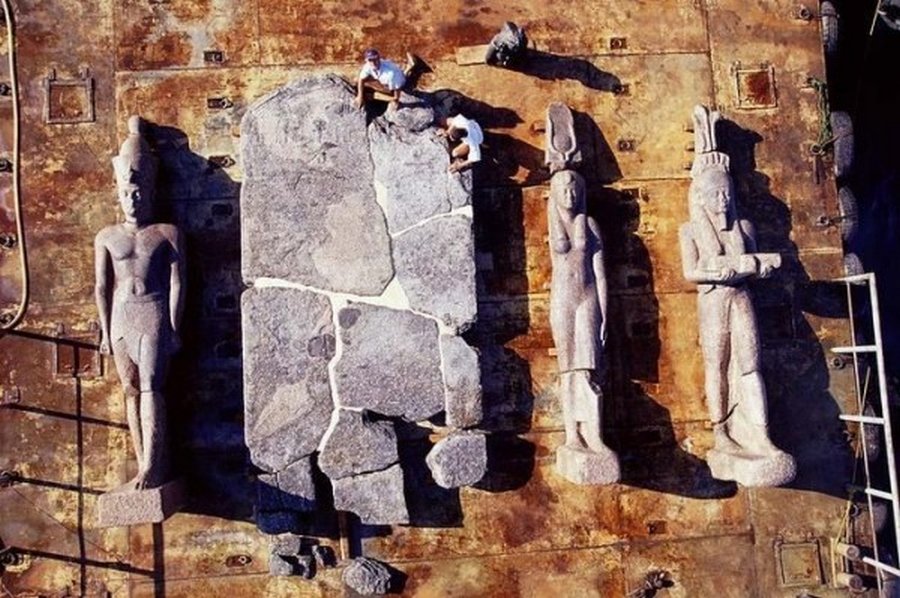 Photos by Franck Goddio 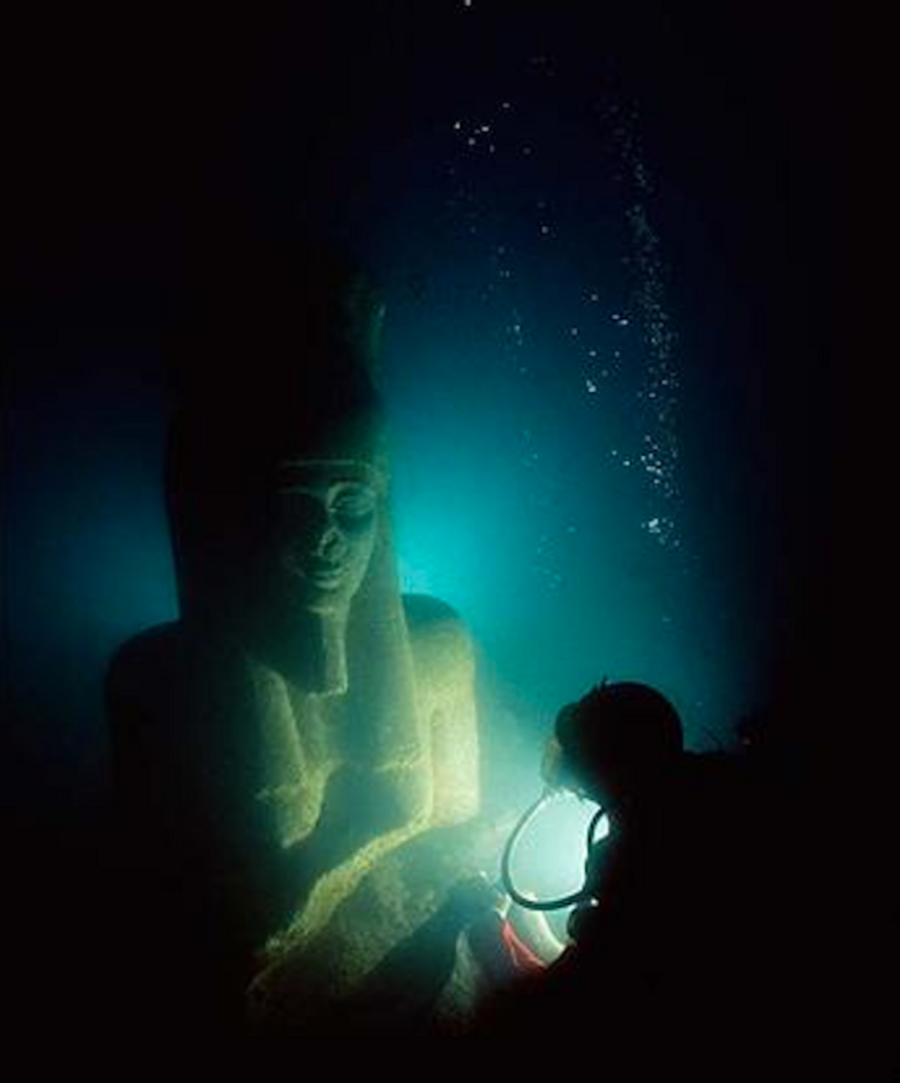 Photos by Franck Goddio A colossal statue
of red granite (5.4 m) representing the god Hapy, god of the Nile flood
and symbol of abundance and fertility decorating the temple of
Heracleion. Never before was such a huge statue of Hapy or any other god
discovered in Egypt, which in... ©Franck Goddio/Hilti Foundation, photo: Christoph Gerigk
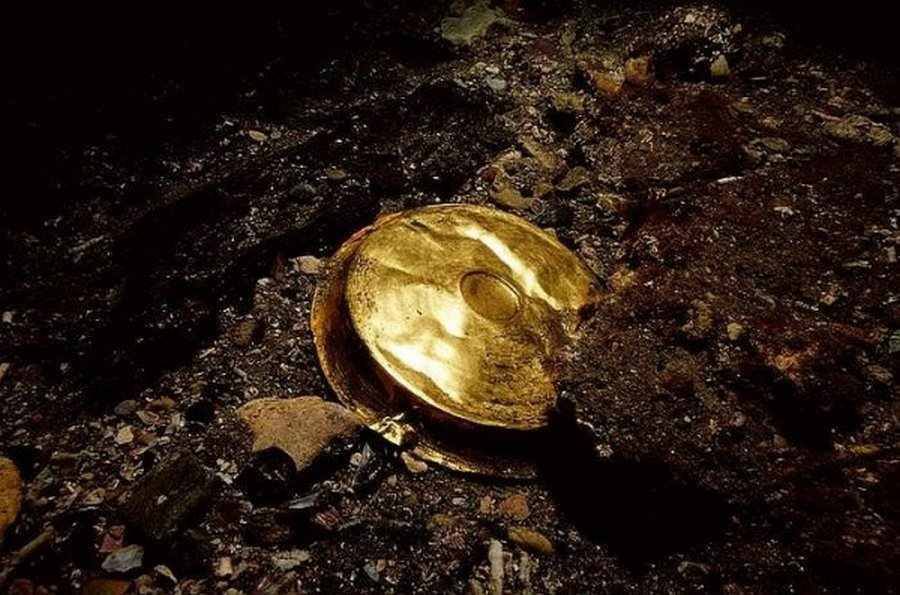 Photos by Franck Goddio A gold vessel
(Phiale) recovered from Thonis-Heracleion. Phiale were shallow dishes
used throughout the Hellenistic world for drinking and pouring
libations. ©Franck Goddio/Hilti Foundation, photo: Christoph Gerigk
Photos by Franck Goddio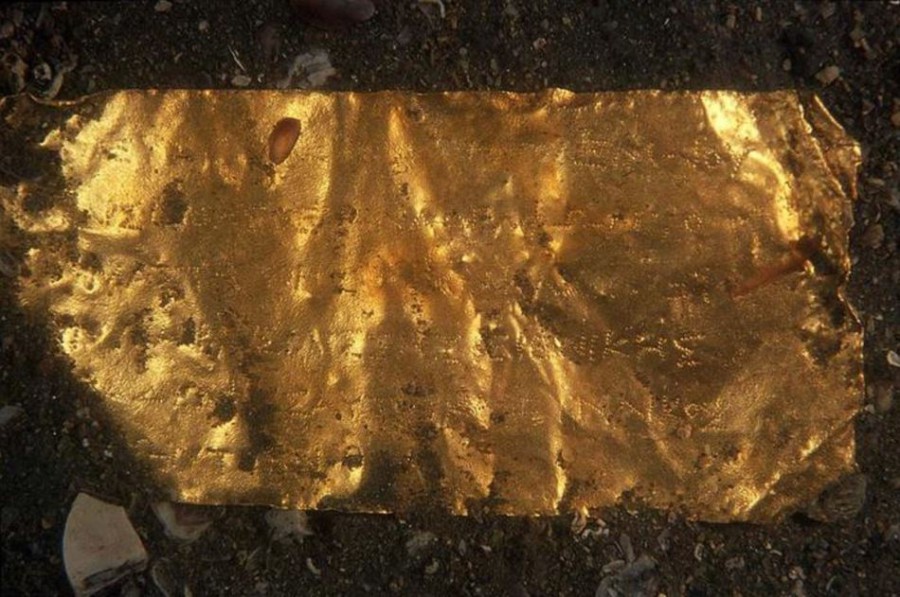
Gold plaque (11 x 5 cm)
engraved with a Greek text of five and a half lines found during
preliminary exploration of the southern sector of Heracleion. It is an
example of the plaques added to foundation deposits as dedications from
donators, here king, Pt
©Franck Goddio/Hilti Foundation, photo: Christoph Gerigk 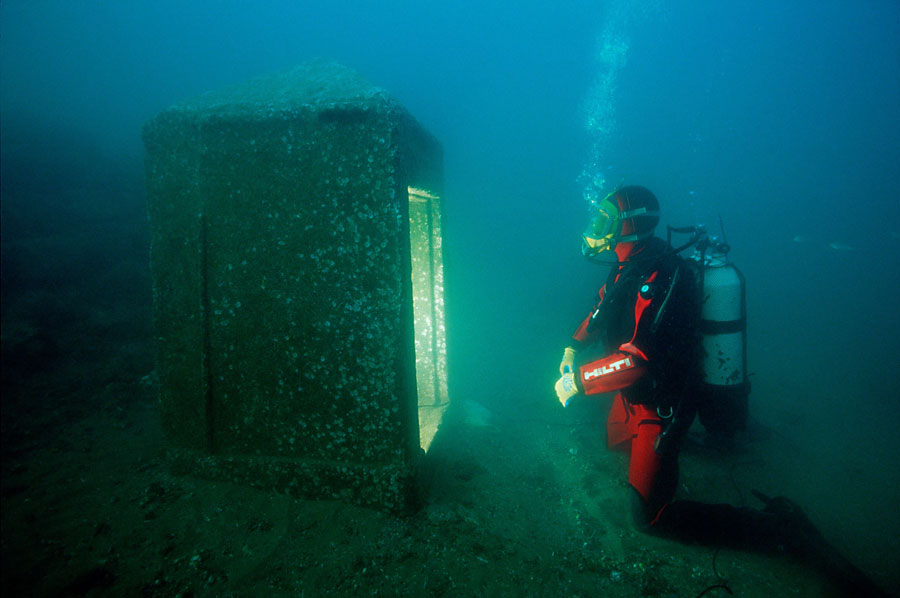  Photos by Franck Goddio
Bronze statuette of pharaoh of the
26th dynasty, found at the temple of Amon area at Heracleion. The
sovereign wears the “blue crown” (probably the crown of the accession).
His dress is extremely simple and classical: the bare-chested king wears
the traditional shendjyt kilt or loincloth. ©Franck Goddio/Hilti Foundation, photo: Christoph Gerigk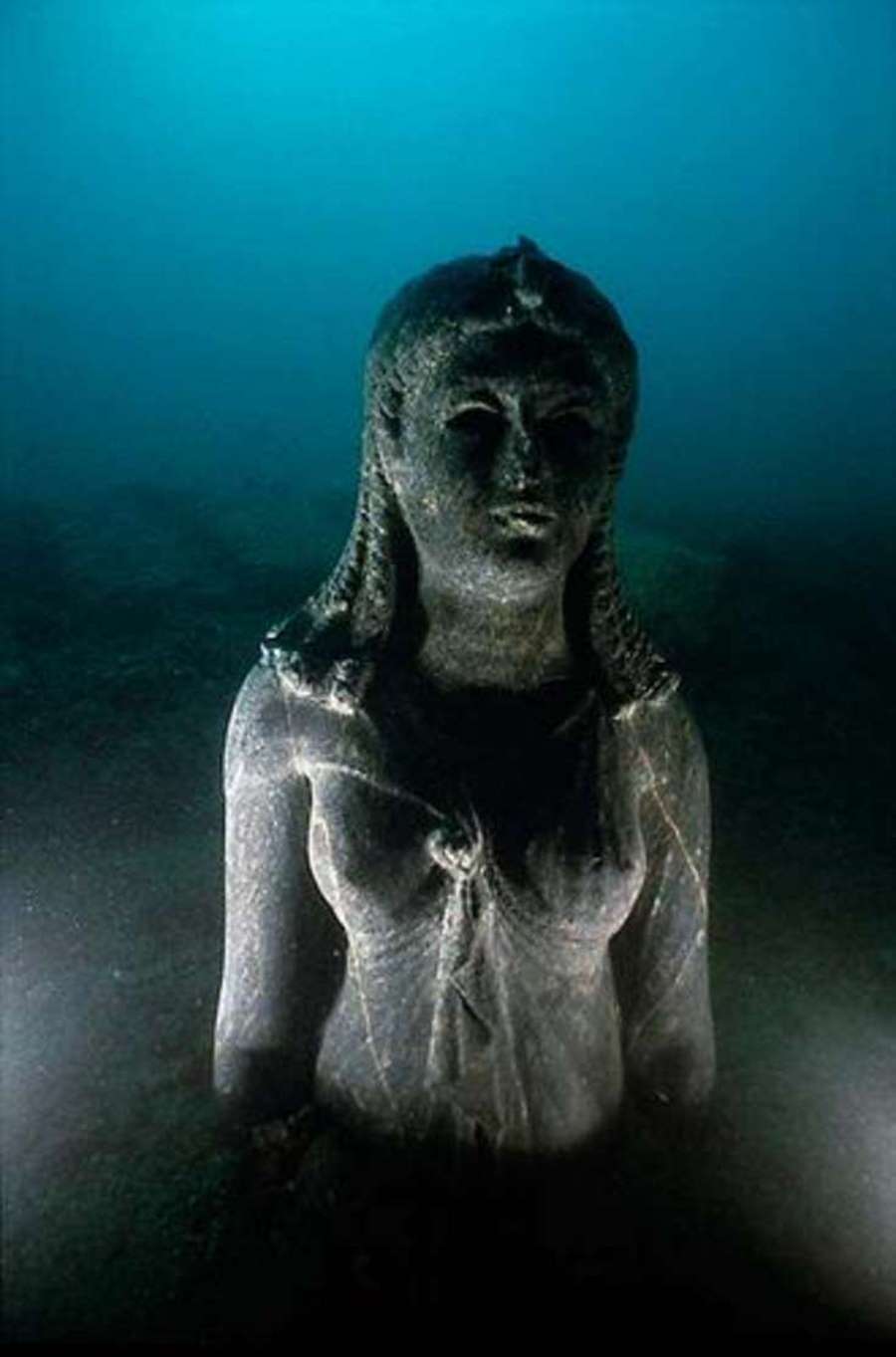 Photos by Franck Goddio One of the
finest finds in Abukir Bay is the remarkable dark stone statue of a 3rd
century Ptolemaic queen, very probably Cleopatra II or Cleopatra III,
wearing the tunic of the goddess Isis. ©Franck Goddio/Hilti Foundation, photo: Christoph Gerigk
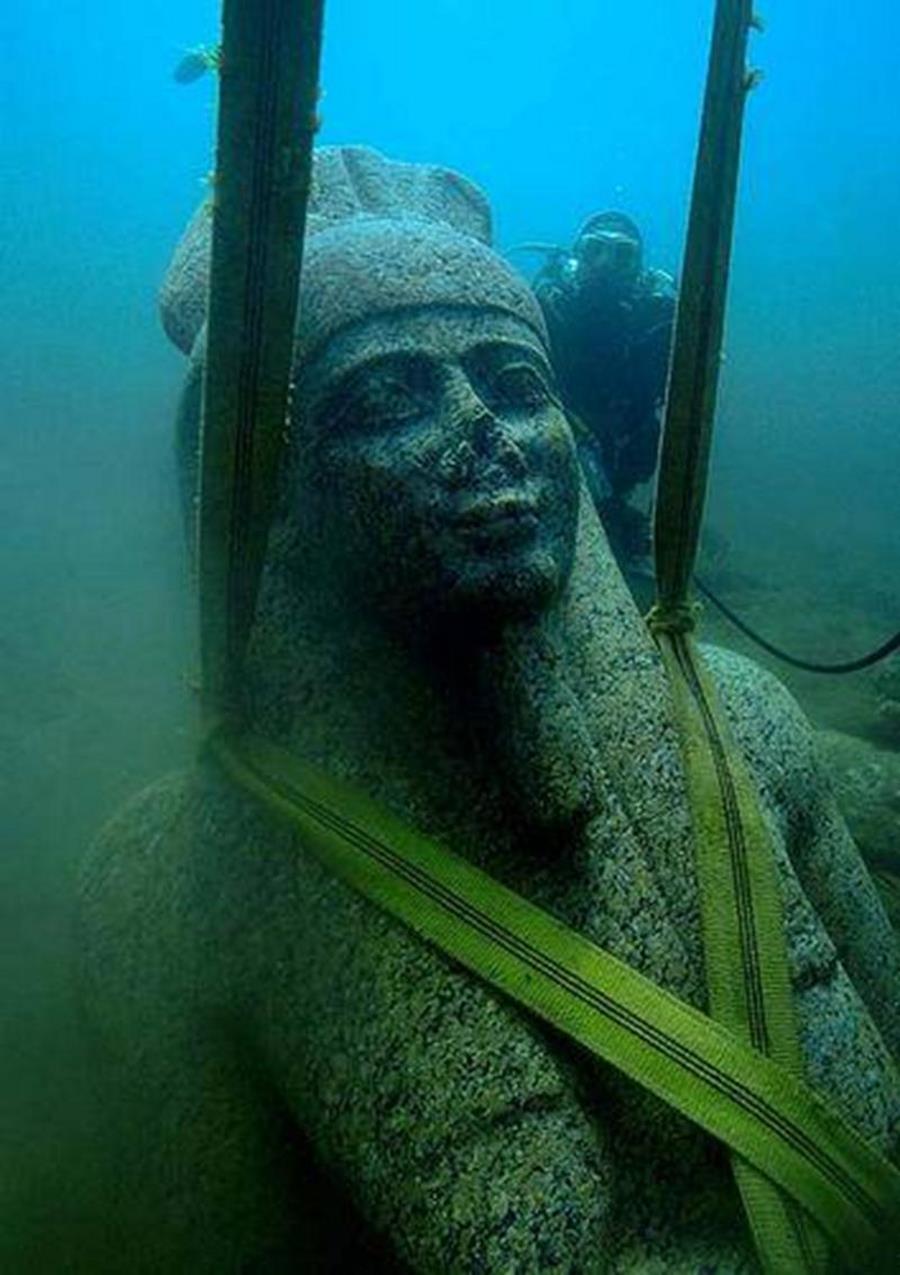 Photos by Franck Goddio Colossal statue
of red granite (5.4 m) representing Hapy, god of the Nile flood and
symbol of abundance and fertility decorating the temple of Heracleion.
Never before was such a huge statue of Hapy or any other god discovered
in Egypt, which indicates Ha
©Franck Goddio/Hilti Foundation, photo: Christoph Gerigk 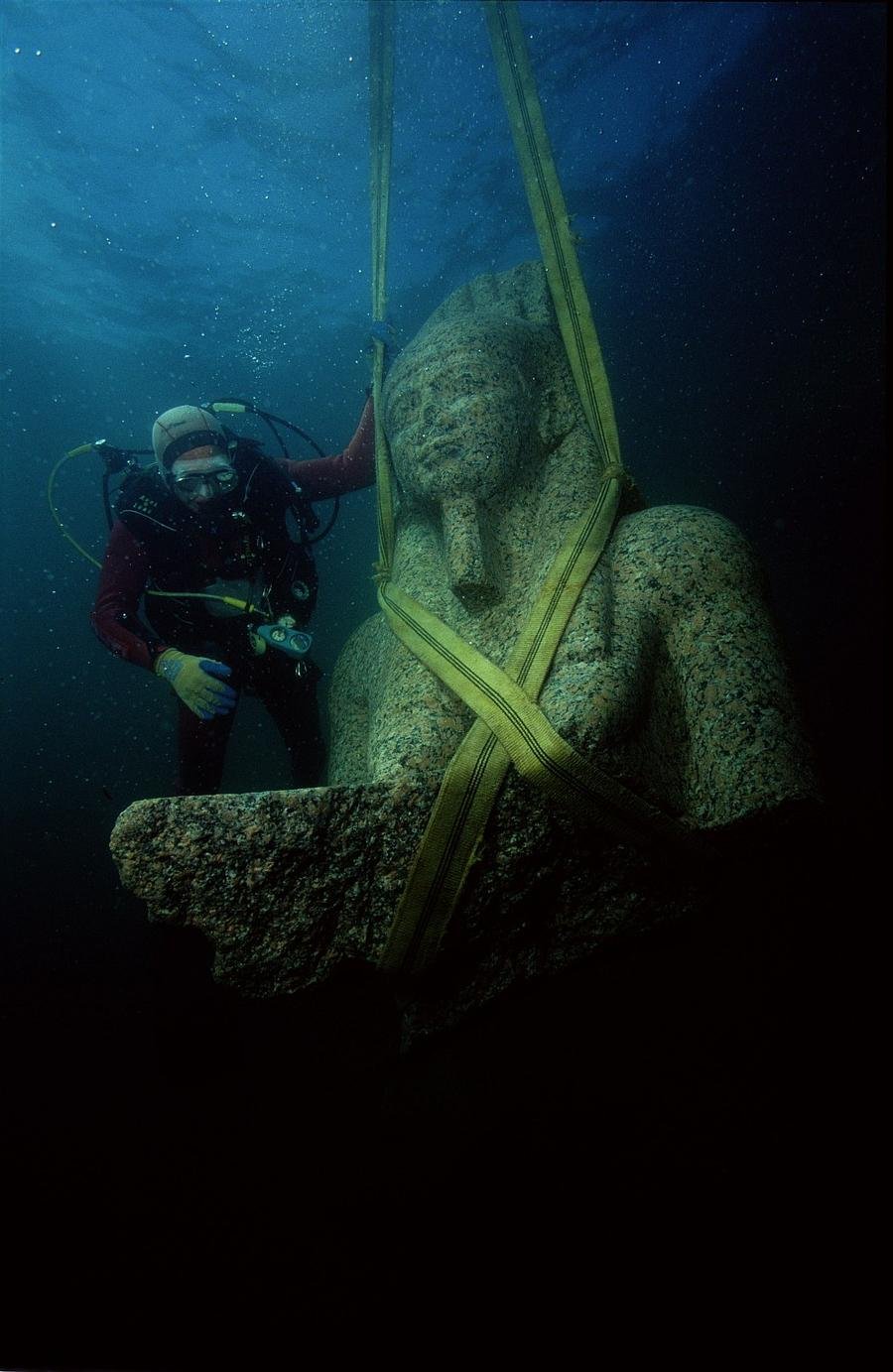 Photos by Franck Goddio A colossal
statue of red granite (5.4 m), representing the god Hapy, god of the
Nile flood and symbol of abundance and fertility decorating the temple
of Heracleion. Never before was such a huge statue of Hapy or any other
god discovered in Egypt, which i
©Franck Goddio/Hilti Foundation, photo: Christoph Gerigk 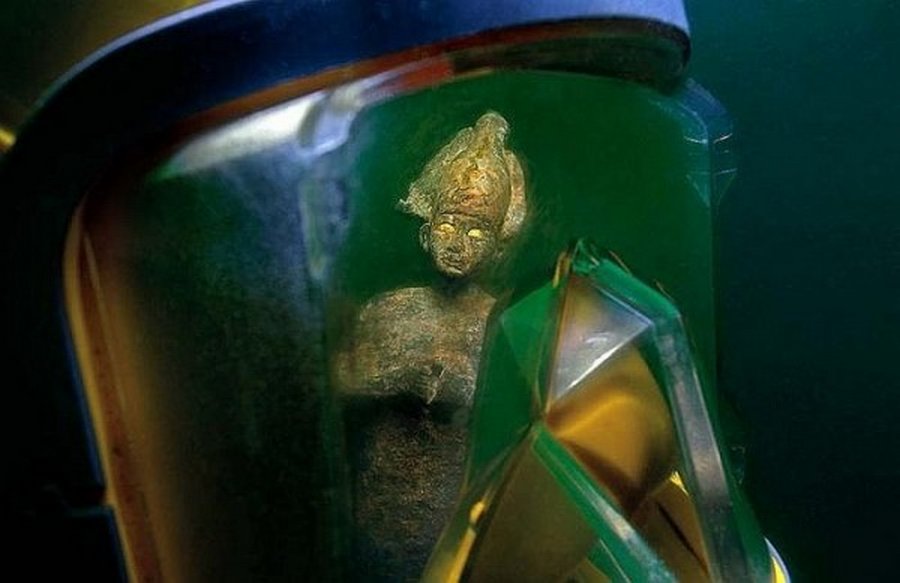 Photos by Franck Goddio
Bronze statue of Osiris, the
assassinated and resurrected king-god. It is adorned with the atef
crown. The typical insignia of power (crook and flail) are missing. Its
open eyes are accentuated by fine gold sheets. ©Franck Goddio/Hilti Foundation, photo: Christoph GerigkSOURCE: 1,200 Year-Old Ancient Egyptian City Discovered Underwater
Thonis-Heracleion: From Legend to Reality - Franck Goddio Official Site |
|
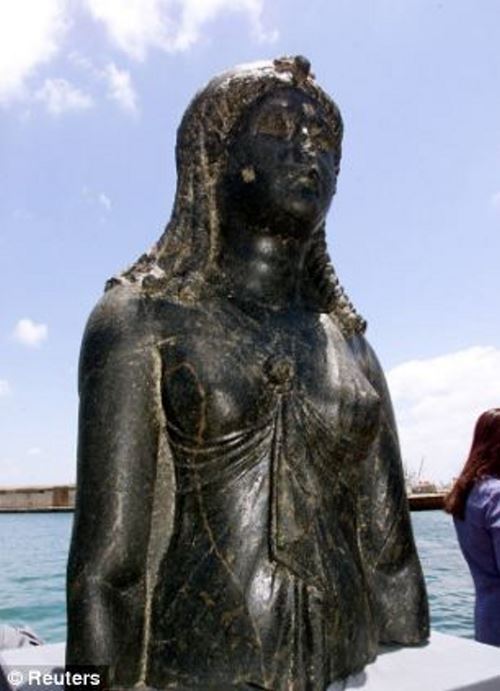 The statue of the Goddess Isis sits on display on a barge in an Alexandrian naval base.
Related Links:
Papers:
|
|
| FAIR USE NOTICE: This page contains copyrighted material the use of which has not been specifically authorized by the copyright owner. Pegasus Research Consortium distributes this material without profit to those who have expressed a prior interest in receiving the included information for research and educational purposes. We believe this constitutes a fair use of any such copyrighted material as provided for in 17 U.S.C § 107. If you wish to use copyrighted material from this site for purposes of your own that go beyond fair use, you must obtain permission from the copyright owner. | |
|
|

